
- RJ Harvey should be the receiving back for the Denver Broncos: No team throws to running backs more than a team coached by Sean Payton.
- High opportunity for touches: The Broncos had one of the lowest team grades for running backs last season. They lost their lead back in Javonte Williams, and Harvey has been the only addition.
- Final chance to claim 25% off PFF+: Use code DRAFT25 and unlock access to player grades, fantasy tools and the 2025 Draft Guide
Estimated Reading Time: 5 minutes

PFF’s Fantasy Football Player Profile series delivers the most in-depth fantasy football analysis available for the 2025 season.
Using PFF’s exclusive data, we evaluate player performance, competition for touches and how teammates and coaching staffs will impact each player’s fantasy football outlook.
Last updated: 7:15 a.m. Tuesday, April 29
Click here for more draft tools:
NFL Draft Big Board | Mock Draft Simulator | NCAA Premium Stats
2025 PFF Draft Guide | Mock Draft Hub | Prospect Data Profiles
Draft Position Rankings
Player performance
Harvey worked his way up the depth chart while at UCF. He barely played in 2021 but played very efficiently as a backup in 2022 and further improved his efficiency in a much larger role in 2023 and 2024. He improved despite UCF jumping from the American Athletic Conference (AAC) to the Big 12. His PFF rushing grade against Power-Five opponents was 93.4 over the past three years, which was just ahead of Blake Corum, Quinshon Judkins and TreVeyon Henderson, and just below Cameron Skattebo, Damien Martinez and Bucky Irving.
Harvey’s numbers as a receiver were generally high throughout his collegiate career. His grade notably declined in 2024, but that was mainly due to a fumble and two drops. On a small sample of 22 receptions and 31 targets, one fumble can make a significant difference in grade.
Our draft guide focused mainly on the positives, including great elusiveness that led to avoided tackles in both the run and pass game. When our draft analysts were asked to name their favorite prospect, our lead draft analyst, Trevor Sikkema, listed Harvey. He has a unique size for a running back, measuring at 5-foot-8 and 205 pounds at the combine. Devonta Freeman was the most notable running back of that size to find NFL success, with Darrell Henderson and Michael Carter also showing flashes.
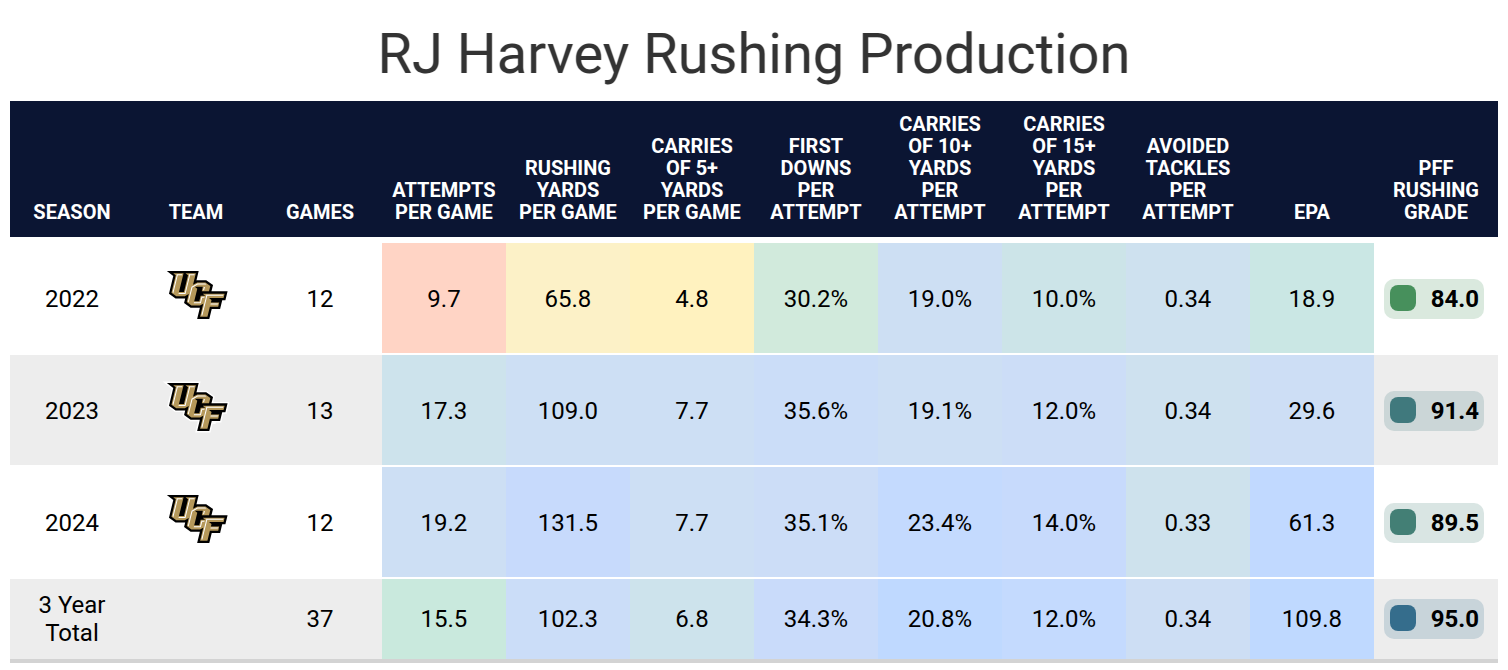
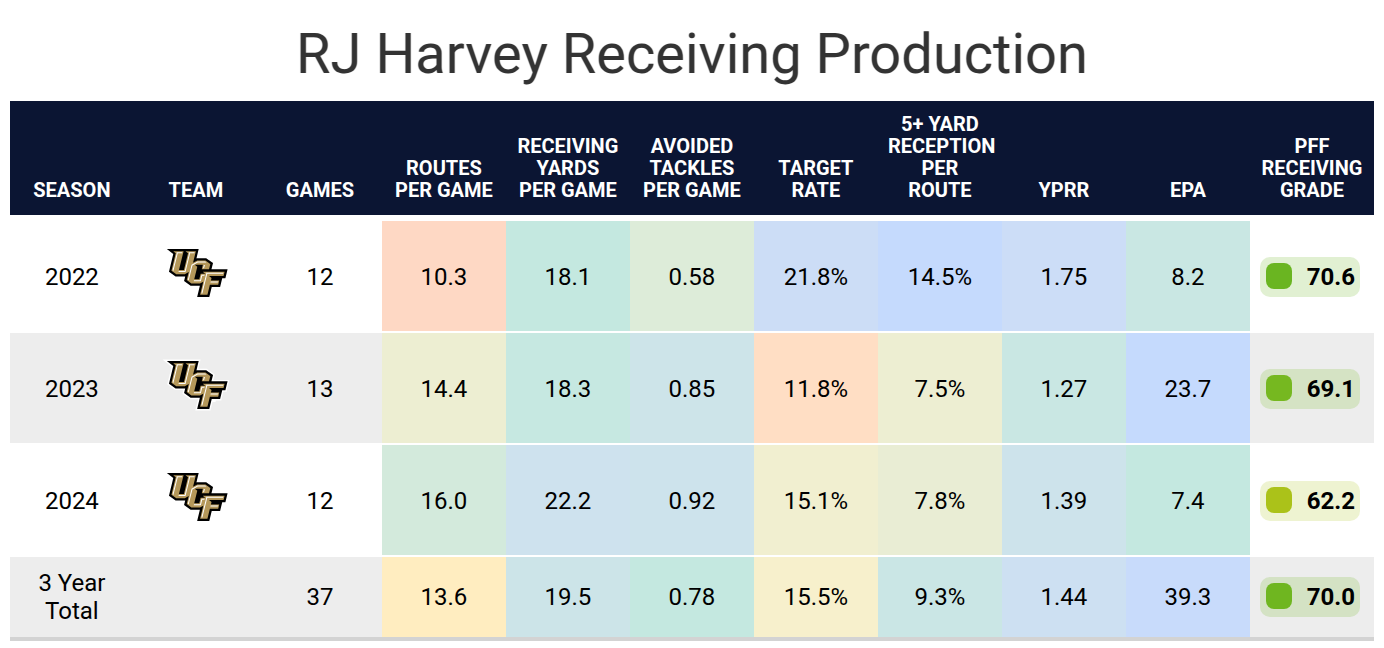
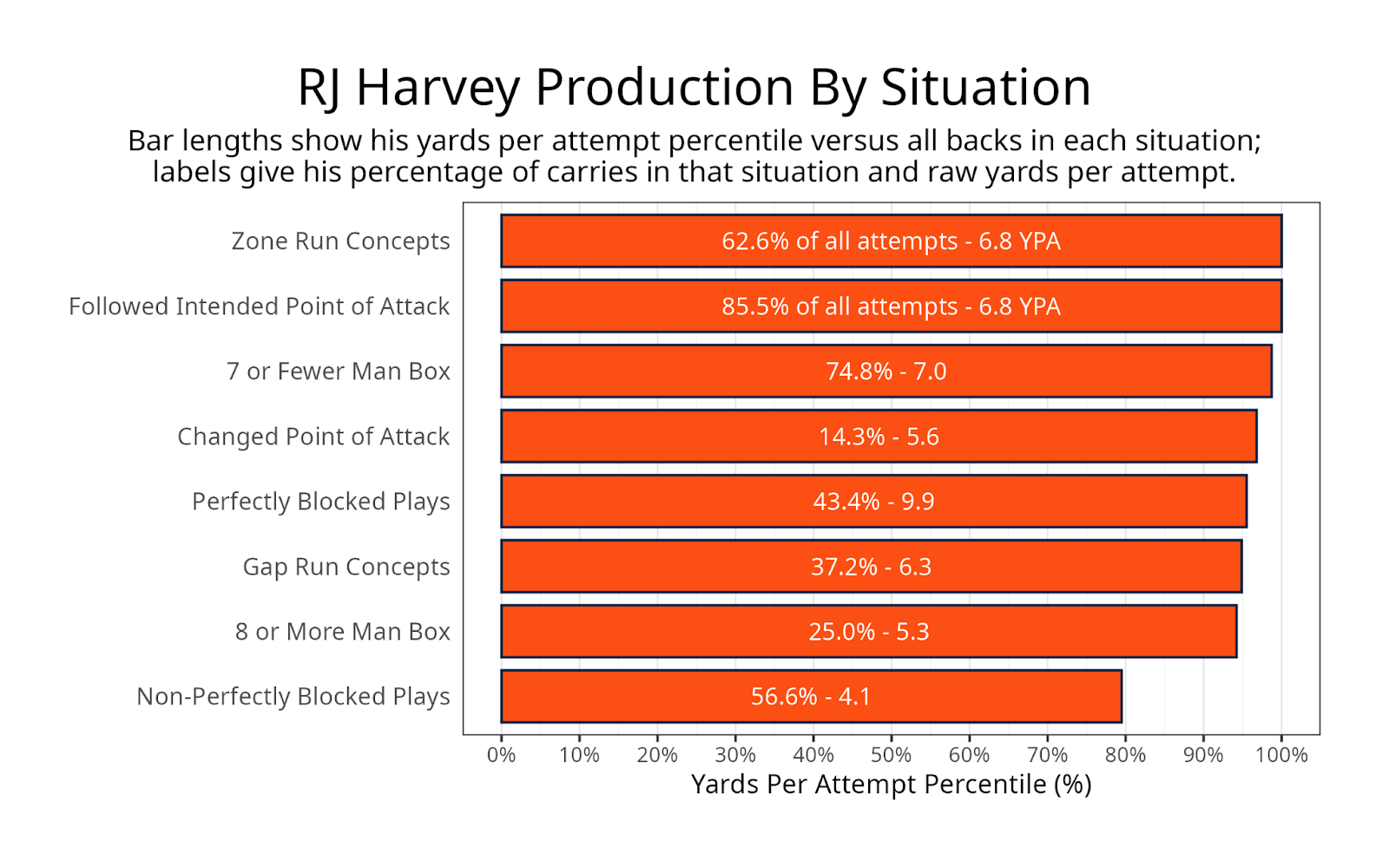
Projected role
Harvey spent the last two seasons as a feature back, but he was consistently on the field more frequently for passing situations than for early downs. His primary role with the Broncos will likely be in passing situations. Denver utilized a rotation of backs between Javonte Williams, Jaleel McLaughlin and Audric Estime. The only changes this offseason were Williams’ departure to the Dallas Cowboys and the Harvey addition. Williams ran 303 routes last season, which was more than double any other running back.
A big reason for optimism for Harvey is that there’s an opportunity to play on early downs as well. McLaughlin and Estime have surpassed 10 carries just twice in their career. Chances are all three will see time on early downs, and whoever is playing the best will start playing more snaps. The one concern is that at the goal line, we could see Estime get most of the touches. McLaughlin is an even smaller back than Harvey, but Estime is the clear biggest back of the three. However, the Broncos didn’t use a clear goal-line back last season, with snaps at the goal line mirroring snaps in any other normal situation.
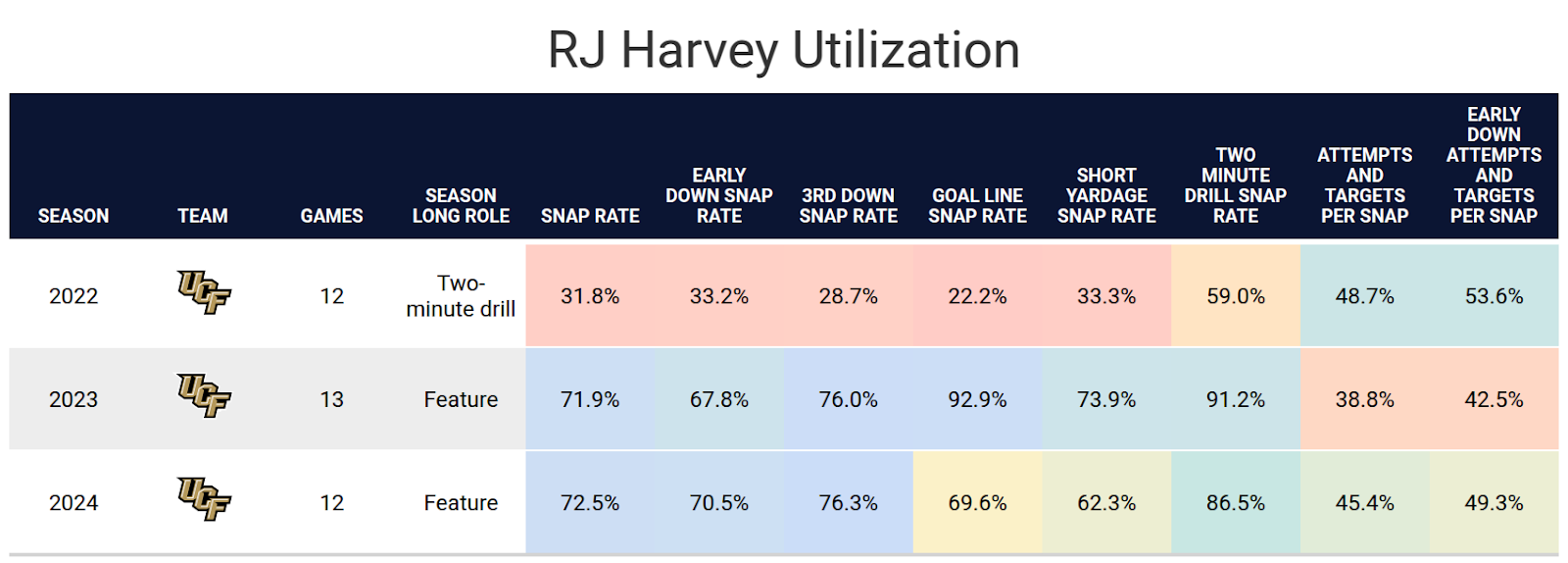
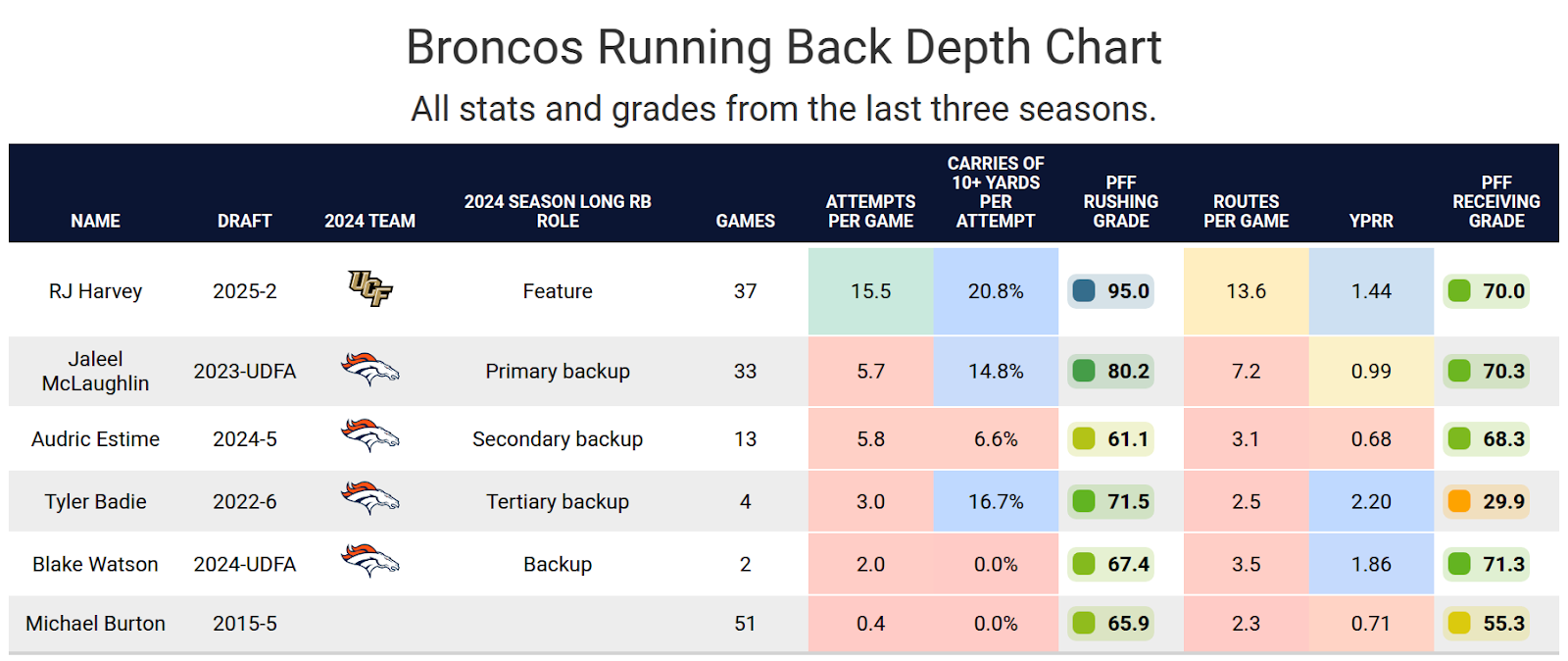
Impact of teammates
A big reason for optimism for Harvey is that he gets to play in Sean Payton’s offense. Broncos running backs have caught 214 passes over the past two years, which is more than any other team. Back with the Saints, Payton had Reggie Bush, Darren Sproles, Pierre Thomas and Alvin Kamara, who were all fantasy-relevant, at times, even in part-time roles. For example, Kamara was selected 67th overall compared to Harvey, who was selected 60th. Kamara was a backup as a rookie and played 44.9% of his team’s offensive snaps over the season. Kamara finished fourth in fantasy points per game that season with 120 carries and 81 receptions.
However, it’s worth remembering that the Broncos’ backfield has been very volatile in the past two seasons. The person with the most carries one week didn’t help predict who would lead in carries the next. There were several times when Payton said someone would see an increased role, but they didn’t. Their player usage in the preseason was also generally misleading about who would make the roster and who would be starting. Ideally, Harvey will stabilize the backfield so that the past two years won’t matter, but that’s no guarantee.
The Broncos’ offensive line is generally more of an asset than a liability. The line stayed very healthy last season, with all five starters playing at least 850 snaps and at least 14 of 18 games, including the playoffs. Denver retained all five linemen for this season. Lines generally play better the more snaps they receive together. However, all five players are also at a point in their careers where you wouldn’t expect much more improvement.

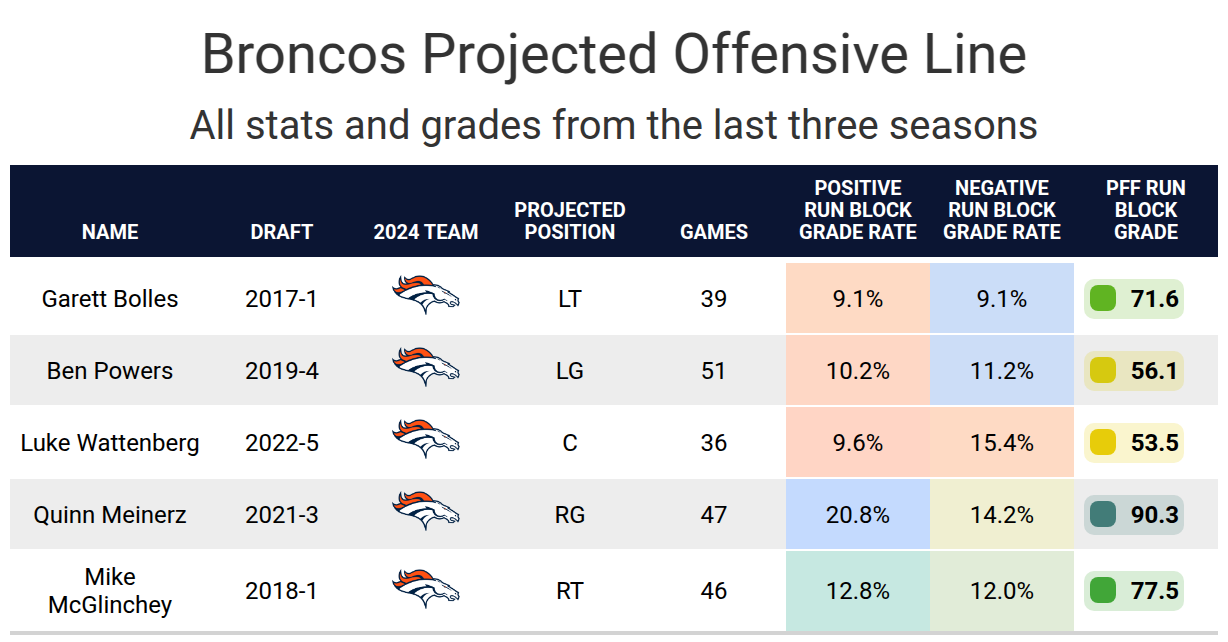
Bottom line
Harvey was arguably the biggest winner in the draft at running back because he landed on a team where his skill set could lead to fantasy stardom. A top-10 season is within the realm of possibility if he dominates the passing down role and also averages at least eight carries per game. However, the Broncos’ backfield could remain volatile despite the addition of Harvey.
Footnotes
- Statistics in tables and charts were chosen based on their ability to predict future fantasy performance on a per-game or per-opportunity basis or to describe the player relative to others at the same position.
- “Opportunities” are defined as passing dropbacks, rushing attempts and routes run as a receiver.
- Numbers are provided either by season or based on the past three years. For rookies, only college statistics are included. For non-rookies, only NFL statistics are considered, regardless of whether they played in college within the previous three years.
- As college competition is easier than NFL competition, most rookies are likely to see a decline from their historical numbers.
- Only FBS data is considered for college players and comparisons.
- Kneel-downs are removed from rushing data to provide cleaner quarterback rushing rate statistics.
- The table colors in this article range from blue (indicating good/high) to red (indicating bad/low).
- All percentiles and color codings compare the given player to others with a high sample of opportunities. Generally, the cutoff is one-third of the possible opportunities in the sample. If a player does not meet the threshold, they are still included in the comparison, though their results may appear better or worse than expected due to the smaller, less predictive sample size.
- Information on utilization classifications and their importance can be found here for running backs, wide receivers and tight ends.
Do Not Include In Article
This paragraph will be used in articles like rankings and perfect draft articles as a short summary on a player. The following three notes will be used in the rankings/player profile tools.
Harvey was arguably the biggest winner in the draft at running back because he landed on a team where his skill set could lead to fantasy stardom. Denver Broncos running backs have caught 214 passes over the past two years, which is more than any other team, and Harvey is projected to be the Broncos’ primary receiving back. A top-ten season is within the realm of possibility if he dominates the passing down role and also averages at least eight carries per game. However, the Broncos’ backfield could remain volatile despite the addition of Harvey.
His PFF rushing grade against Power-5 opponents was 93.4 over the past three years, which was just ahead of Blake Corum, Quinshon Judkins and TreVeyon Henderson, and just below Cam Skattebo, Damien Martinez and Bucky Irving.
Broncos running backs have caught 214 passes over the past two years, which is more than any other team.
The Broncos‘ offensive line is generally more of an asset than a liability. The line stayed very healthy last season, with all five starters playing at least 850 snaps and at least 14 of 18 games, including the playoffs. Denver retained all five linemen for this season.
This news was originally published on this post .




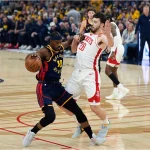


Be the first to leave a comment